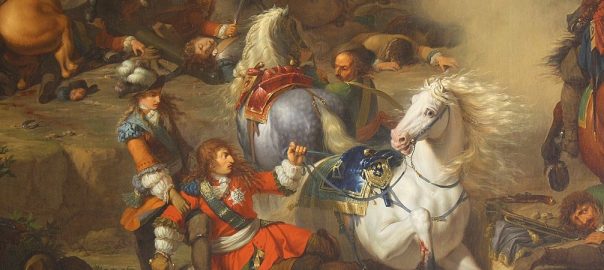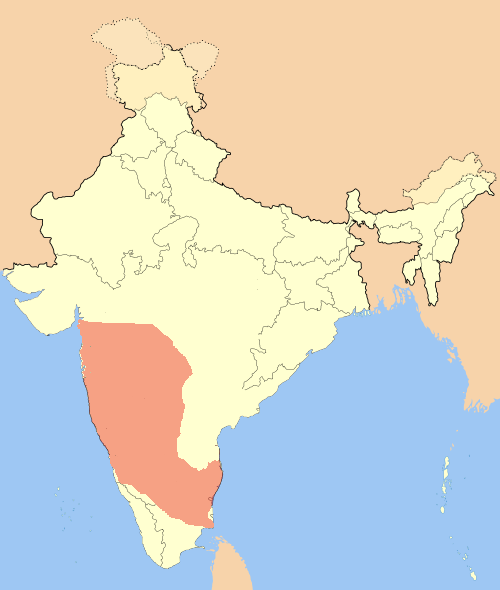In 1674 CE, the main development in world affairs was the crowning of the Maratha Hindu leader Shivaji as Chhatrapati (“paramount sovereign”)– potentially of all of India. The growth of Maratha power under Shivaji was starting to pose a challenge to the control the (Afghan-origined) Mughals had been exercising over much of the subcontinent over recent decades. Scroll on down to learn more.
In 1674 in Western Europe, the French war effort against the Dutch continued, greatly complicated at the beginning of the year by the defection of the English from their previous alliance with Louis XIV– and also by the fact that the Spanish and other Habsburgs were now joining with the (very Protestant) Dutch to try to push back French power.
There were a number of battles in the Low Countries that straddled the northeast border of France. The largest of these was the Battle of Seneffe, fought in August 1674. This page on English-Wikipedia surmises that, “While this was a French victory, the appalling casualties confirmed Louis’ preference for positional warfare, ushering in a period where siege and manoeuvre dominated military tactics.” There were also some smaller battles between the French and the Spanish at their direct border in the south, and in Sicily.
Throughout the year, the anti-French alliance was fractured by the differing war aims of its participants. WP notes this, too: “The Dutch were further split by internal disputes; the powerful Amsterdam mercantile body were anxious to end an expensive war once their commercial interests were secured, while William saw France as a long-term threat that had to be defeated. This conflict increased once ending the war became a distinct possibility… “
But for now, this messy, violent war in continental Europe was dragging on.
(By the way, the banner image above is a detail from an 18th-century painting of the young son of the French military commander Louis de Bourbon, Prince of Condé, helping rescue his father after his horse was shot out from under him at the Battle of Seneffe.)
One 1674 development concerning the Dutch UPs’ global empire was the shuttering of the initial West India Company (GWC) that a group of Dutch merchants had established in 1621. By now, the GWC was mired in debt, so it was dissolved. However, this page on WP tells us that a new version was established in 1675, with a capitalization that reached more than 6 million guilders. Gotta chase those profits wherever you can find them!
But meantime, in India…
Shivaji is crowned Chhatrapati
We’ve met Shivaji before. He led a couple of daring plunder raids against the main Mughal port of Surat, using a navy he had created for himself (and also, intriguingly, not doing any plundering of the English and other European warehouses sited there.)
Shivaji, who as far as I can figure fought in the name of Hindutva (Hindu Pride) as well as the ancient culture of his Maratha people, had himself come from a fairly low Hindu caste– the shudra (cultivator) caste. Now, he wanted to receive acclaim as, and be treated as, a national leader for the Marathas, and maybe for all of (Hindu) India. But first, he had to finagle the caste issue. You can read how he did that, here.
At one point in performing those preparatory rites, he had to “make atonement” for the sins he had committed in his own lifetime (as opposed to during previous lifetimes, I guess.) Then this happened:
Two learned Brahmans [Brahmins] pointed out that Shivaji, while conducting his raids, had burnt cities which resulted in the death of Brahmans, cows, women and children, and now could be cleansed of this sin for a price of only Rs. 8,000, and Shivaji paid this amount.
Boy, does this sound like the Catholic church selling “indulgences”!
So the ceremonies went ahead. English-WP tells us this:
Shivaji was crowned king of Maratha Swaraj [self-rule] in a lavish ceremony on 6 June 1674 at Raigad fort. In the Hindu calendar it was on the 13th day (trayodashi) of the first fortnight of the month of Jyeshtha in the year 1596. Gaga Bhatt officiated, holding a gold vessel filled with the seven sacred waters of the rivers Yamuna, Indus, Ganges, Godavari, Narmada, Krishna and Kaveri over Shivaji’s head, and chanted the Vedic coronation mantras. After the ablution, Shivaji bowed before Jijabai [his mother] and touched her feet. Nearly fifty thousand people gathered at Raigad for the ceremonies. Shivaji was entitled Shakakarta (“founder of an era”) and Chhatrapati (“paramount sovereign”). He also took the title of Haindava Dharmodhhaarak (protector of the Hindu faith).
This whole thing cost nearly 5 million rupees.
In 1674, Shivaji also launched an aggressive campaign to enlarge his territories. WP tells us this:
In the run-up to his expedition Shivaji appealed to a sense of Deccani patriotism, that Southern India was a homeland that should be protected from outsiders. His appeal was somewhat successful… In 1677, Shivaji invaded Karnataka with 30,000 cavalry and 40,000 infantry, backed by Golkonda artillery and funding. Proceeding south, Shivaji seized the forts of Vellore and Gingee; the latter would later serve as a capital of the Marathas during the reign of his son Rajaram I.
While all this was going on, the Mughal Emperor, Aurangzeb, was busy directing battles against Afghan invaders in the north. Soon enough, he would be forced to come back south and deal with these Marathas… Stay tuned.



